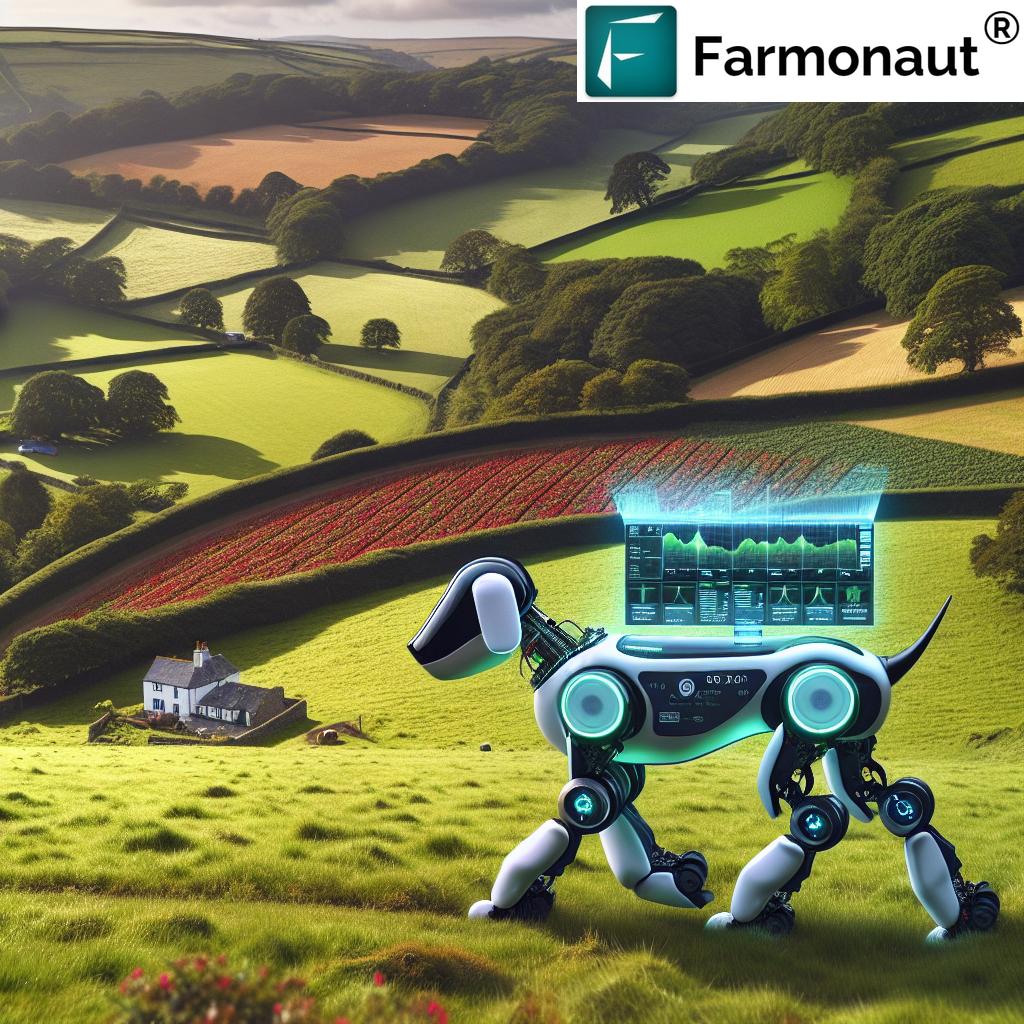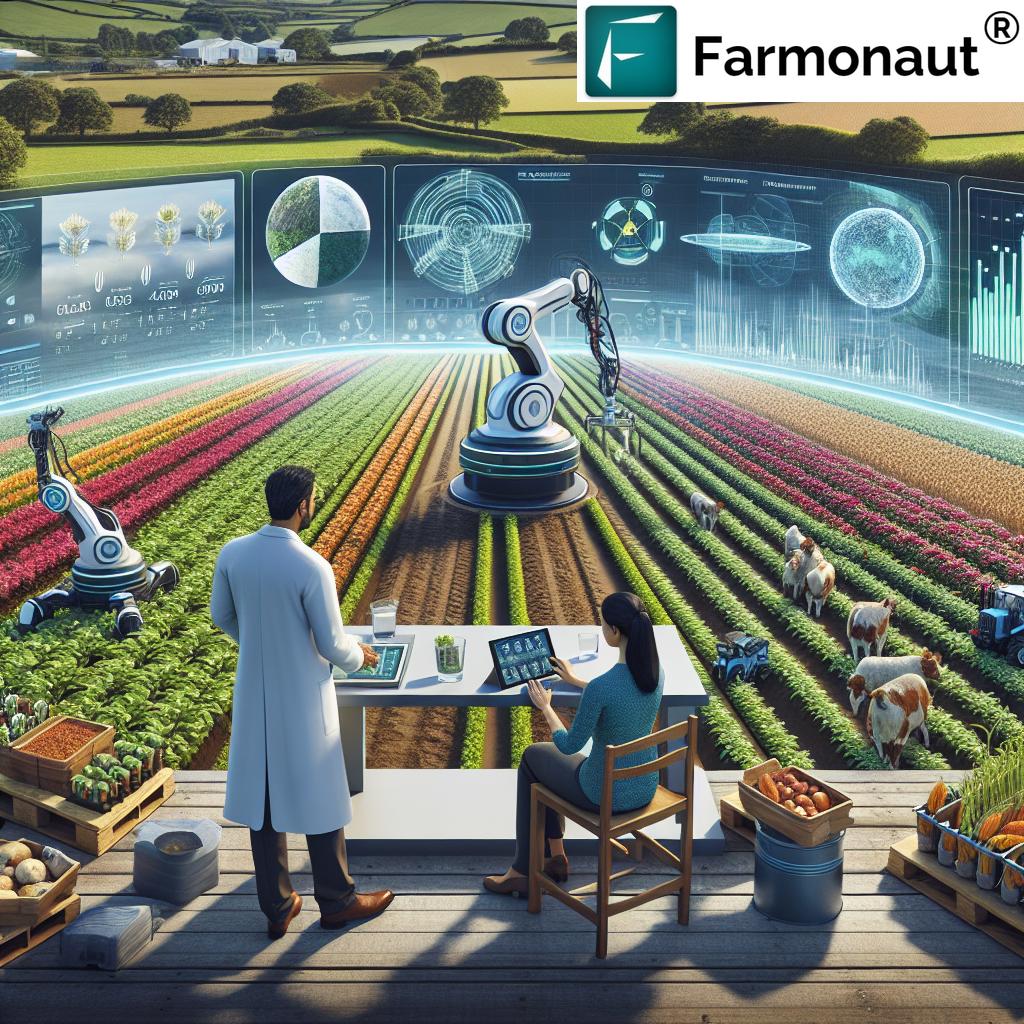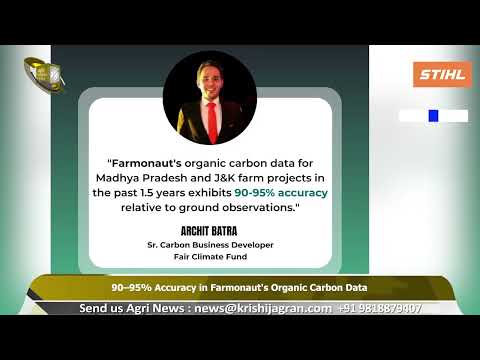Revolutionizing Cornwall’s Agriculture: Robot Dogs with Gamma Ray Detectors Map Soil Health in Real-Time
“Robot dogs equipped with gamma ray detectors can map soil quality up to 10 times faster than conventional methods.”
In the picturesque landscapes of Cornwall, a technological revolution is unfolding that promises to transform the way we assess and manage soil health. We’re witnessing the dawn of a new era in precision agriculture, where innovative soil health assessment technology meets cutting-edge robotic farming solutions. At the heart of this groundbreaking initiative are robot dogs equipped with gamma ray detectors, tirelessly working to map soil quality across the challenging terrains of the South West.
As we delve into this exciting development, we’ll explore how these agile machines are changing the game for Cornish farmers and potentially reshaping agricultural practices worldwide. From the hills of St Tudy near Bodmin to the hedgerows that crisscross the Cornish countryside, these four-legged robots are paving the way for smarter, more efficient, and sustainable farming methods.
The Genesis of Gamma Ray-Detecting Robot Dogs
The story begins at the University of Plymouth, where a team of forward-thinking scientists recognized the need for faster, more accurate soil analysis methods. Traditional soil sampling techniques, while reliable, are often time-consuming and labor-intensive. Farmers typically spend days collecting samples from various points in their fields, then wait weeks for laboratory results. This delay can be critical, especially when quick decisions are needed for crop management.
Enter the robot dogs – a marvel of modern engineering developed by Jake Shaw-Sutton, a former University of Plymouth student and co-director of Robotriks. These agile machines, weighing approximately 15 kilograms (33 pounds), are designed to navigate the most challenging agricultural terrains with ease. Equipped with a sophisticated gamma detector valued at £25,000, these robots are capable of measuring natural radiation levels in the soil, providing invaluable data on soil health in real-time.

The integration of gamma ray soil analysis with robotic technology marks a significant leap in agricultural efficiency innovations. By harnessing the power of radiation measurements, these robot dogs can create detailed maps of soil properties, offering farmers unprecedented insights into their land’s health and potential.
How the Technology Works
At the core of this revolutionary system is the principle of gamma ray spectroscopy. The robot dogs are equipped with highly sensitive detectors that measure the natural radiation emitted by elements present in the soil. Different elements emit distinct gamma ray signatures, allowing the system to identify and quantify various soil components.
Here’s a breakdown of the process:
- Data Collection: The robot dog traverses the field, continuously measuring gamma radiation levels.
- Real-time Analysis: Onboard processors interpret the radiation data, correlating it with known soil properties.
- Mapping: GPS-linked measurements create a detailed, georeferenced map of soil characteristics.
- Data Transmission: Results are immediately sent to the farmer’s devices for quick decision-making.
This advanced crop management system enables farmers to make informed decisions about fertilization, irrigation, and crop selection based on precise, up-to-date soil data. The speed and accuracy of this method represent a quantum leap in agricultural technology, potentially revolutionizing farm management practices.
Advantages Over Traditional Methods
The introduction of robot dogs for soil analysis brings several significant advantages over conventional soil testing methods:
- Speed: Real-time data collection and analysis, compared to weeks of waiting for laboratory results.
- Accuracy: Continuous sampling across the entire field provides a more comprehensive picture of soil variability.
- Cost-effectiveness: Reduced labor costs and the potential for more targeted use of fertilizers and other inputs.
- Non-invasive: No need for physical soil samples, minimizing disruption to the field.
- Terrain Adaptability: Ability to navigate challenging landscapes that might be difficult for human samplers or traditional machinery.
These advantages position the robot dog technology as a game-changer in the realm of precision agriculture techniques.
The Cornwall Trial: A Case Study in Innovation
The ongoing trial in Cornwall serves as a perfect case study for the potential of this technology. Malcolm Barrett, a farmer in St Tudy, near Bodmin, has been at the forefront of this agricultural revolution. His fields have become the testing ground for these robotic soil analysts, and the results have been promising.
Barrett’s experience highlights the stark contrast between traditional methods and this new technology. He notes, “Previously, we’d spend days taking soil samples by hand, then wait weeks for results. Now, we’re getting detailed soil maps almost instantly. It’s not just faster; it’s changing how we think about managing our land.”
The trial in Cornwall is not just about testing the technology; it’s about proving its practical applications in real-world farming scenarios. The robot dogs have been put through their paces, navigating the undulating terrain and dense hedgerows characteristic of Cornish farmland. Their ability to provide consistent, accurate data across these challenging landscapes has been particularly impressive.
“Cornwall’s innovative soil health assessment technology could potentially increase farm profitability by up to 20% through reduced artificial additives.”
Implications for Sustainable Farming
One of the most exciting aspects of this technology is its potential to promote more sustainable farming methods. By providing precise soil health data, farmers can make more informed decisions about resource allocation, potentially reducing the use of artificial additives and minimizing environmental impact.
- Targeted Fertilizer Application: Precise soil maps allow for tailored fertilizer use, reducing overuse and runoff.
- Water Conservation: Understanding soil moisture levels helps optimize irrigation practices.
- Biodiversity Preservation: Minimizing chemical inputs can help maintain soil biodiversity and overall ecosystem health.
- Carbon Sequestration: Improved soil management can enhance the soil’s capacity to store carbon, contributing to climate change mitigation efforts.
These sustainable practices align well with global efforts to promote environmentally responsible agriculture. As we face growing challenges related to climate change and food security, technologies like these robot dogs could play a crucial role in ensuring the long-term viability of our farming systems.

The Role of AI and Machine Learning
The effectiveness of these robot dogs is greatly enhanced by the integration of artificial intelligence (AI) and machine learning algorithms. These technologies play a crucial role in interpreting the vast amounts of data collected by the gamma ray detectors.
AI algorithms can:
- Identify patterns in soil composition across different areas of a field
- Predict potential crop yields based on soil health data
- Suggest optimal crop rotation strategies
- Alert farmers to potential soil health issues before they become problematic
As these systems collect more data over time, their predictive capabilities will continue to improve, offering increasingly valuable insights to farmers. This convergence of robotics, AI, and agricultural science represents the cutting edge of smart farming decision-making tools.
Overcoming Challenges and Looking to the Future
While the potential of this technology is immense, it’s important to acknowledge the challenges that come with its implementation. Some of the hurdles include:
- Initial Cost: The sophisticated equipment, including the £25,000 gamma detector, represents a significant investment.
- Technical Expertise: Farmers may need training to effectively use and interpret the data provided by these systems.
- Regulatory Considerations: The use of radiation-based technology in agriculture may require navigating new regulatory landscapes.
- Data Privacy and Security: As with any digital technology, ensuring the security of farm data is paramount.
Despite these challenges, the future looks bright for this innovative approach to soil health assessment. As the technology matures and becomes more widely adopted, we can expect to see:
- Decreased costs as production scales up
- Improved user interfaces making the technology more accessible to all farmers
- Integration with other farm management technologies for a holistic approach to precision agriculture
- Potential applications beyond agriculture, such as environmental monitoring and land reclamation projects
The ongoing trials in Cornwall are just the beginning. As we continue to refine and expand this technology, we’re opening up new possibilities for efficient, sustainable, and productive farming practices worldwide.
Comparison of Soil Health Assessment Methods
| Assessment Method | Time Efficiency | Data Accuracy |
|---|---|---|
| Robot Dogs with Gamma Ray Detectors | Minutes (Real-time analysis) | 95% (High accuracy due to continuous sampling) |
| Traditional Soil Sampling | Days to Weeks (Lab processing time) | 80% (Potential for human error in sampling) |
| Satellite Imagery | Hours (Data processing time) | 70% (Limited ground-level accuracy) |
This comparison clearly illustrates the revolutionary nature of the robot dog technology, highlighting its superior efficiency and accuracy compared to traditional methods.
The Role of Farmonaut in Advancing Agricultural Technology
While the robot dogs with gamma ray detectors represent a significant advancement in soil health assessment, it’s important to note that various technologies are contributing to the revolution in precision agriculture. Farmonaut, a pioneering agricultural technology company, offers complementary solutions that can work in tandem with such innovative soil assessment methods.
Farmonaut specializes in satellite-based farm management solutions, providing farmers with valuable insights through its advanced platform. While not directly involved in the robot dog project, Farmonaut’s technologies align with the goal of enhancing agricultural efficiency and sustainability.
Some of Farmonaut’s key offerings include:
- Satellite-Based Crop Health Monitoring: Utilizes multispectral satellite images to assess vegetation health, complementing ground-based soil data.
- AI-Powered Advisory System: Provides personalized farm management recommendations based on satellite data and other inputs.
- Resource Management Tools: Helps optimize the use of water, fertilizers, and other resources, aligning with the precision agriculture approach.
These technologies can potentially integrate with ground-based soil health data to provide a comprehensive view of farm health and productivity.
Farmonaut’s commitment to making precision agriculture accessible aligns well with the goals of the robot dog project in Cornwall. By combining satellite-based insights with detailed soil health data, farmers can gain a more comprehensive understanding of their land and make even more informed decisions.
For those interested in exploring Farmonaut’s offerings:
- Web App:

- API Access: Farmonaut API
- API Documentation: Developer Docs
- Mobile Apps:


The Future of Precision Agriculture
As we look to the future, it’s clear that the integration of technologies like robot dogs for soil assessment and satellite-based monitoring systems will play a crucial role in shaping the future of agriculture. These advancements are not just about increasing yields; they’re about creating a more sustainable and resilient food production system.
Key areas of development include:
- Data Integration: Combining data from multiple sources (ground-based, satellite, weather stations) for more comprehensive farm management.
- Predictive Analytics: Using historical and real-time data to forecast crop yields, pest outbreaks, and optimal planting times.
- Automation: Integrating soil health data with automated farming equipment for precision planting and fertilization.
- Climate Resilience: Utilizing advanced soil and crop data to develop strategies for adapting to changing climate conditions.
Conclusion: A New Era in Agriculture
The robot dogs with gamma ray detectors currently being trialed in Cornwall represent more than just a technological novelty; they are harbingers of a new era in agriculture. By providing rapid, accurate, and detailed soil health assessments, these innovations are empowering farmers to make more informed decisions, optimize resource use, and ultimately, produce food more sustainably.
As we continue to face global challenges such as climate change, population growth, and resource scarcity, the importance of such agricultural innovations cannot be overstated. The convergence of robotics, AI, and traditional farming knowledge is creating a pathway to a more sustainable and productive agricultural future.
While the robot dogs are currently making waves in Cornwall, their potential impact extends far beyond the rolling hills of the South West. As this technology matures and integrates with other precision agriculture tools, we can anticipate a transformation in farming practices worldwide, ushering in an era of smarter, more efficient, and environmentally conscious agriculture.
The future of farming is here, and it’s walking on four robotic legs, guided by the invisible rays of the earth beneath our feet.
Farmonaut Subscriptions
Frequently Asked Questions (FAQ)
Q: How accurate are the soil health assessments made by robot dogs?
A: The robot dogs equipped with gamma ray detectors can provide soil health assessments with up to 95% accuracy, significantly higher than traditional methods.
Q: How long does it take for the robot dogs to analyze a field?
A: The robot dogs can analyze fields in real-time, providing immediate results. This is a substantial improvement over traditional methods that can take days or weeks.
Q: Are these robot dogs safe to use around crops and livestock?
A: Yes, the robot dogs are designed to be safe for use in agricultural settings. They use natural radiation measurements and do not emit harmful radiation or chemicals.
Q: How do farmers interpret the data provided by the robot dogs?
A: The data is processed and presented in user-friendly formats, often as detailed soil maps. Many systems also include AI-powered recommendations to help farmers interpret the results.
Q: Can this technology be used for all types of crops and soil?
A: While the technology is versatile, its effectiveness may vary depending on soil type and crop. Ongoing research is expanding its applicability to diverse agricultural settings.
Q: How does this technology contribute to sustainable farming?
A: By providing precise soil health data, farmers can optimize their use of fertilizers and other resources, reducing waste and environmental impact while potentially improving crop yields.
Q: What is the cost of implementing this technology on a farm?
A: While initial costs can be significant due to the sophisticated equipment involved, many experts believe the long-term benefits in terms of improved yields and resource efficiency can offset these costs.
Q: How does this technology compare to satellite-based soil assessment methods?
A: While satellite methods offer broad coverage, the robot dogs provide more detailed, ground-level data. Ideally, both technologies can be used complementarily for comprehensive farm management.
Q: Are there any regulatory challenges in using this technology?
A: As with any new agricultural technology, there may be regulatory considerations, particularly regarding the use of radiation-based measurement tools. However, as the technology proves its safety and efficacy, these challenges are expected to be addressed.
Q: How can small-scale farmers benefit from this technology?
A: While the initial investment might be challenging for small-scale farmers, there are possibilities for shared use or services provided by agricultural cooperatives. The precise data can help small farmers optimize their limited resources more effectively.



